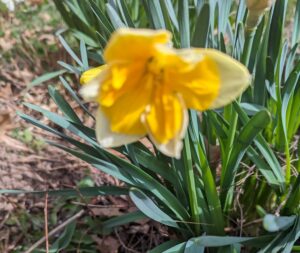 The daffodil or narcissus season has well and truly started in my garden with the arrival of the single-flowered early bloomers. I always plant odd numbers of bulbs in large holes so the blooms emerge bouquet-fashion into the early spring sunshine. I have seen miniature daffodils pop out as early as the end of February in extremely mild winters, but usually the first of mine come up in mid-March, braving occasional days of unseasonable cold and shining through like troupers.
The daffodil or narcissus season has well and truly started in my garden with the arrival of the single-flowered early bloomers. I always plant odd numbers of bulbs in large holes so the blooms emerge bouquet-fashion into the early spring sunshine. I have seen miniature daffodils pop out as early as the end of February in extremely mild winters, but usually the first of mine come up in mid-March, braving occasional days of unseasonable cold and shining through like troupers.
The one thing that the earliest varieties have in common is single trumpets, which blast out the spring news and amp up the floral drama after the delicate opening acts provided by the crocuses and snowdrops.
As in many dramatic and operatic productions, the real divas make their entrances later and with great fanfare. Once our eyes have become accustomed to flowers taller than four inches, and those single daffodil trumpets seem less miraculous, the double-flowered prima donnas emerge, with the aim of upstaging everyone else on stage.
In earliest spring, double-flowered daffodils would seem too opulent and fussy. With spring well underway, they become a celebration. I grow as many varieties as I can, because, as Oscar Wilde said, “Nothing succeeds like excess.”
There are probably many opinions about the origins of double daffodils. At least one source asserts that they developed from Narcissus pseudonarcissus, which is a European native. Double of petals in many species usually begin as spontaneous genetic mutations. Sometimes those mutations are sterile and die out, but occasionally they produce viable seed, and that leads, eventually, to generations of offspring. This must have happened with double daffodils, aided, as the centuries progressed, by breeders.
Scores of doubles are on the market today. If I had acres and acres, I would grow them all. Since I have a slightly larger than average suburban garden, I have to pick and choose.
One of my favorites is also one of the oldest varieties in cultivation, Alba Plenus Oderatus, the double pheasant’s eye daffodil, in cultivation since before the seventeenth century. Also known as Narcissus poeticus ‘Plenus’, it is related to the single-flowered poeticus daffodils, which are distinguished by extremely small yellow cups or “eyes” rimmed in red, with green centers. That eye is lost in the double-flowered variety, which makes up for that deficiency with a cloud of delicate, fragrant white petals. Scott Kunst, founder of Old House Gardens, calls ‘Plenus’ “an erratic bloomer”, but I have not found it to be so. Its blooms come very late in the daffodil season, but it is well worth the wait.
Three of the loveliest doubles in my opinion, are slightly newer antique varieties, all bearing the name of their celebrated English breeder, William Copeland. Pale yellow and white ‘Irene Copeland’, introduced in 1915, looks almost like a double dahlia or chrysanthemum. The daffodil named for Irene’s sister, ‘Mary Copeland’, has somewhat fewer double petals, but a blazing orangy center. ‘Mrs. William Copeland’, introduced in 1930 and named for the mother of Mary and Irene, looks a little more like the primrose and white Irene, but with paler petals. Growing them all together would bring this hundred year-old family together in early to mid spring.
The vogue for double-flowered varieties has waxed and waned over the decades, but breeders have never really stopped producing them. Many beautiful modern varieties grace the retail marketplace. I like ‘Gay Tabor’, which many sources describe as “camellia-like”, with large, rounded white petals, accented with swirling orange petaloids. It is another mid-spring bloomer.
I am fond of pink-cupped daffodils and have long grown the first one, ‘Mrs. R.O. Backhouse’, which has single flowers and an apricot trumpet. For something pink and gaudy, try the Irish-bred ‘Delnashaugh’, which mixes a mass of large, rounded white petals, with a plethora of frilled apricot petals. As with all “pink” daffodils, the degree of pinkness is relative and often lean more towards peach than true pink. They are lovely, but may disappoint gardeners looking for “Barbie pink”.
Many daffodils, including doubles, have fragrance, but ‘Rose of May’ has divine fragrance. It was also bred in Ireland and introduced into commerce in 1950. The petals are pure white, and the plants flourish best in long cool springs. I am expecting that this year, and hoping that I will get a good show from my ‘Rose of May ‘daffodils, which generally appear a bit earlier than the name suggests.
I once saw an ad—which lives on via You Tube–that featured an actor portraying a Russian oligarch surrounded by acres of gilded furniture, expensively clad women, and a tiny giraffe on a plump cushion. The tag line was “Opulence—I has it.” With double daffodils in the garden, there are many spring days when I can say the same thing.
